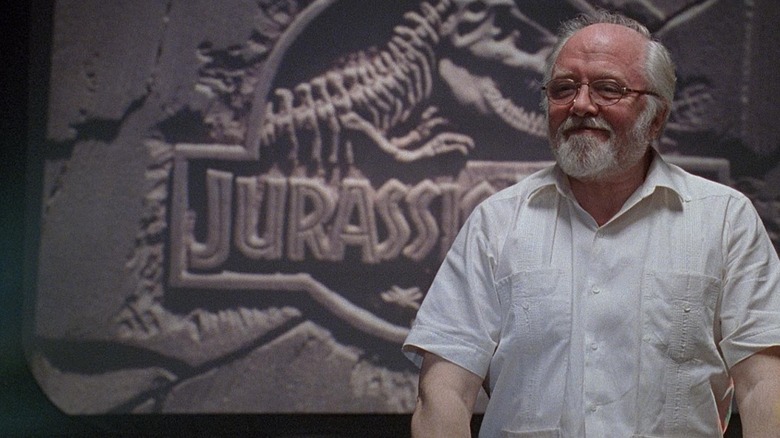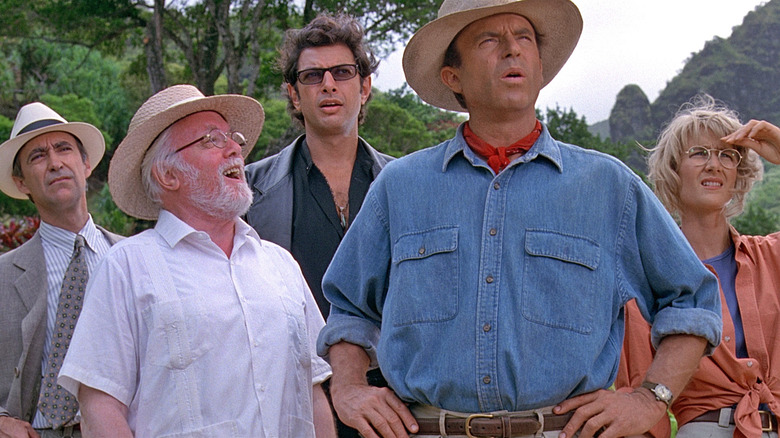One Of Jurassic Park's Simplest Scenes Took Over 20 Takes To Film
An interesting piece of trivia: Steven Spielberg's 1993 film "Jurassic Park" only had 63 effects shots in it. Compare that to Colin Trevorrow's 2015 sequel "Jurassic World," which had over 2,000 VFX shots, and somehow doesn't look as good. Because CGI technology was so expensive and difficult to use in 1992, back when "Jurassic Park" was being filmed, Spielberg had to use it tactfully, blending practical effects and computer effects to capture the visuals he wanted. Indeed, a rarely-used form of stop-motion animation (nicknamed go-motion because of its added motion blur) was rejected in favor of trying out the newer technology, hoping to create dinosaurs that looked as believable as possible.
The effort meant a longer, more meticulous process of matching models to CGI figures, keeping a lot of monster action off camera, and keeping the human characters foregrounded (both in the frame, and in the drama). Shooting wrapped on November of 1992 with the special effects were finally completed the following May. The film hit theaters in June.
Spielberg prides himself on being an efficient filmmaker, and, according to his assistant director John T. Kretchmer, he has an unwritten rule to never do more than seven takes on a single setup. It seems that, in Spielberg's mind, if you can't get it in seven, you can't get it. Kretchmer revealed, however — at a "Jurassic Park" 25th anniversary Q&A at Universal Studios Hollywood, that there was one scene in "Jurassic Park" that Spielberg required over 20 takes to complete. Surprisingly, it was not one of the 63 effects shots, had no models in it, and it had no stunts.
The scene in question
The scene in question was, in fact, a scene from the beginning of the film wherein Dr. John Hammond (Richard Attenborough) was proposing that Dr. Sattler (Laura Dern) and Dr. Grant (Sam Neill) visit a mysterious, privately owned, dinosaur-related island dig that he personally owned to get their feedback on his work and approve of the site's safety. In the scene, Hammond popped a bottle of champagne to celebrate their potential employment, happy to gain a stamp of approval from a paleobotanist and a paleontologist.
The scene instigates the film's action, and presented a lot of exposition. Hammond has only to lay out a few basic plot points, and Grant and Sattler don't yet know about the coming dinosaurs that will appear later in the film. There is nothing dramatically strenuous for the actors, and the characters merely have to listen. A scene of this nature would require little beyond mere clarity; make sure the audience knows why they're here. Indeed, too much style in an exposition scene can distract from the story and Spielberg is too canny a filmmaker to be lost in empty style in such a fashion. Multiple takes might be needed if there was a problem on set — perhaps planes flew overhead, ruining the sound — or if the actors can't nail the scene for some reason — perhaps someone was struck by a case of the giggles.
This was the final scene shot for "Jurassic Park." As soon as Spielberg announced "Cut! That's a wrap!," shooting on "Jurassic Park" would come to an end. Was something going horrendously wrong on the final shot? Was there a complicated reason for this final scene to carry on for as long as it did?
According to Kretchmer, the reason was far simpler: Spielberg simply didn't want to stop shooting. Nothing was wrong. The best take was in the can. Spielberg simply didn't want the experience to end.
This is my drug
Here is a transcription of what Kretchmer said about the martini shot on "Jurassic Park":
So, I want to tell you about the very last shot we did on the film. It was a retake in the Airstream trailer, and it was a shot of Lord Attenborough – Richard Attenborough – sitting on the counter and raising his champagne glass, and a toast ...
Now when we did the movie, Steven never did more than seven takes on any setup. He shot it very much like a television show. We'd do seven takes, he'd print one and we'd move on. So we're doing this last shot: He does one take, two takes, five takes, seven takes, ten takes, fifteen takes, twenty takes. Finally I take Steven by the elbow and pull him aside, and I say 'Steven, enough.'
And he says, 'You don't understand, this is my drug.' He was so dedicated and didn't want to give up directing. You have to remember, in six weeks he was going to be directing 'Schindler's List.' It wasn't like he was going into retirement. But it just increased my admiration for the man so incredibly, it was the most incredible person to work with.
Indeed, auditions for "Schindler's List" were to take place in December of 1992, and principal photography began in March of 1993. Spielberg would edit scenes in "Jurassic Park" while on the 75-day shoot for "Schindler" (the cognitive whiplash caused by working on both those films in the same day must have been severe). Both "Jurassic Park" and "Schindler's List" were released in 1993. They won 10 Academy Awards between the two of them, and both were among the top-grossing films of that year.
Perhaps there's something to this Spielberg and his dedication to his craft.

